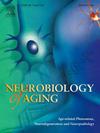Age-related differences in cerebral morphology and microstructure in rhesus macaques
IF 3.7
3区 医学
Q2 GERIATRICS & GERONTOLOGY
引用次数: 0
Abstract
The rhesus macaque presents a promising model for translational research into human brain aging due to this species’ long lifespan and close phylogenic relationship. We conducted a cross-sectional study identifying microstructural and morphological biomarkers of aging in a cohort of 37 healthy animals (18F/19M, aged 5–28 years), using high-resolution T2-weighted (T2w) and diffusion-weighted (DW) images. Using Tensor Based Morphometry, significant age-associated regional brain atrophy was observed in some areas of the frontal and parietal cortex, as well as the striatum. Additionally, age-associated differences in white matter diffusion were observed in several brain regions, including frontal and temporal white matter areas, and regions of the internal capsule and corpus callosum. Taken together, the results demonstrate that morphological and microstructural age-related differences can be disclosed in cortical, striatal, and thalamic regions, as well as in the white matter fiber pathways connecting these areas, using high-resolution DTI and MRI.
恒河猴大脑形态和微观结构的年龄相关性差异
恒河猴具有较长的寿命和密切的系统发育关系,为人类大脑衰老的转化研究提供了一个有希望的模型。我们采用高分辨率t2加权(T2w)和弥散加权(DW)图像,对37只健康动物(18F/19M, 5-28岁)进行了一项横断面研究,以确定衰老的微观结构和形态学生物标志物。使用基于张量的形态测量法,在额叶和顶叶皮层以及纹状体的某些区域观察到明显的与年龄相关的区域脑萎缩。此外,在大脑的几个区域,包括额叶和颞叶白质区域,以及内囊和胼胝体区域,观察到白质扩散的年龄相关差异。综上所述,研究结果表明,使用高分辨率DTI和MRI,可以揭示皮层、纹状体和丘脑区域以及连接这些区域的白质纤维通路中与年龄相关的形态学和微观结构差异。
本文章由计算机程序翻译,如有差异,请以英文原文为准。
求助全文
约1分钟内获得全文
求助全文
来源期刊

Neurobiology of Aging
医学-老年医学
CiteScore
8.40
自引率
2.40%
发文量
225
审稿时长
67 days
期刊介绍:
Neurobiology of Aging publishes the results of studies in behavior, biochemistry, cell biology, endocrinology, molecular biology, morphology, neurology, neuropathology, pharmacology, physiology and protein chemistry in which the primary emphasis involves mechanisms of nervous system changes with age or diseases associated with age. Reviews and primary research articles are included, occasionally accompanied by open peer commentary. Letters to the Editor and brief communications are also acceptable. Brief reports of highly time-sensitive material are usually treated as rapid communications in which case editorial review is completed within six weeks and publication scheduled for the next available issue.
 求助内容:
求助内容: 应助结果提醒方式:
应助结果提醒方式:


